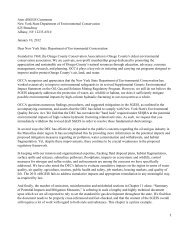Oil and Gas at Your Door? (2005 Edition) - Earthworks
Oil and Gas at Your Door? (2005 Edition) - Earthworks
Oil and Gas at Your Door? (2005 Edition) - Earthworks
Create successful ePaper yourself
Turn your PDF publications into a flip-book with our unique Google optimized e-Paper software.
LEASING<br />
• Requiring l<strong>and</strong>owner approval before a lease can be sold to another company. This prevents<br />
the lease from being sold to an undesirable company. Sometimes companies will<br />
transfer leases without telling the l<strong>and</strong>owner. In a few st<strong>at</strong>es there are laws requiring th<strong>at</strong><br />
l<strong>and</strong>owners be notified within 30 days of a lease transfer. If your st<strong>at</strong>e has such a law, you<br />
can include a provision th<strong>at</strong> autom<strong>at</strong>ically cancels the lease if the company fails to notify<br />
you of such a transfer.<br />
• L<strong>and</strong>owner approval in writing of well, tank, access road <strong>and</strong> pipeline sites. It should be<br />
stipul<strong>at</strong>ed th<strong>at</strong> written l<strong>and</strong>owner approval must be granted before any construction or<br />
drilling occurs. A pl<strong>at</strong> map <strong>at</strong>tached to a lease may be desirable where special l<strong>and</strong> fe<strong>at</strong>ures<br />
(orchards, springs, etc.) should be protected. The maximum width of a combined<br />
access road <strong>and</strong> pipeline easement should be established in the lease (e.g., often it is 40<br />
feet during drilling oper<strong>at</strong>ions <strong>and</strong> 20 feet after a well is completed). The size of the well<br />
drilling site should also be specified.<br />
• Payment of damages for property <strong>and</strong> crops destroyed by the oper<strong>at</strong>ions. Many leases<br />
contain an indemnific<strong>at</strong>ion provision, which makes the oper<strong>at</strong>or liable for any <strong>and</strong> all damage<br />
<strong>and</strong> liability resulting from their oil <strong>and</strong> gas oper<strong>at</strong>ions. This provision should include<br />
wording th<strong>at</strong> makes the company liable for damage to growing crops, trees, fences, buildings,<br />
tile lines <strong>and</strong> drainage ditches, springs, w<strong>at</strong>er wells for homes <strong>and</strong> livestock, other<br />
items of significance to the l<strong>and</strong>owner, <strong>and</strong> all damages to the surface of the lessor’s<br />
property. A l<strong>and</strong>owner should not accept a lease th<strong>at</strong> only provides payment for growing<br />
crops. Such a lease will not entitle the l<strong>and</strong>owner to any other damages, no m<strong>at</strong>ter how<br />
serious they may be. The l<strong>and</strong>owner may want to include provisions allowing him or her to<br />
harvest timber in the area of a proposed well site prior to the company bringing in drilling<br />
equipment; <strong>and</strong> requiring th<strong>at</strong> well heads be fenced in, l<strong>and</strong>scaped, <strong>and</strong> have sound barriers<br />
erected.<br />
• Pipeline Restrictions. Many leases authorize install<strong>at</strong>ion of pipelines or<br />
transmission lines th<strong>at</strong> may be required. A provision authorizing ONLY<br />
pipelines th<strong>at</strong> serve the wells on the l<strong>and</strong>owner’s property is desirable.<br />
Additional pipeline easements should be negoti<strong>at</strong>ed separ<strong>at</strong>ely.<br />
• Burying pipelines <strong>at</strong> a specified depth. Since pipelines may or<br />
may not be buried according to st<strong>at</strong>e regul<strong>at</strong>ions, the l<strong>and</strong>owner<br />
may want to ask the company to bury the line <strong>at</strong> a depth th<strong>at</strong><br />
he or she desires (e.g., below tillage depth). The company laying<br />
the pipeline should be required to file a map of line loc<strong>at</strong>ion<br />
with the l<strong>and</strong>owner.<br />
• Depth of minerals. The mineral owner can specify the depth of<br />
the mineral being leased. There are other minerals th<strong>at</strong> may be<br />
loc<strong>at</strong>ed <strong>at</strong> other depths, <strong>and</strong> those may be leased separ<strong>at</strong>ely.<br />
• Implied Covenants. In virtually all st<strong>at</strong>es, significant mineral owner<br />
protections are implied by law in oil <strong>and</strong> gas leases (for example, requirement<br />
of prudent oper<strong>at</strong>ions, protection against drainage, explor<strong>at</strong>ion <strong>and</strong><br />
development, <strong>and</strong> marketing of oil or gas). The lease should not limit the covenants<br />
normally implied in oil <strong>and</strong> gas leases.<br />
III-27




